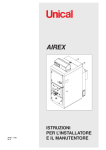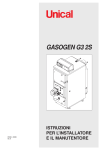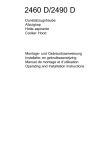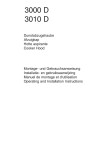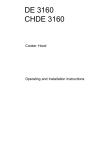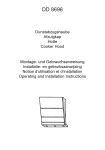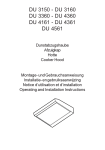Download AEG Electrolux HI 8610 Specifications
Transcript
DI 8610 Dunstabzugshaube Afzuigkap Hotte aspirante Cooker Hood Cappa aspirante Montage- und Gebrauchsanweisung Installatie- en gebruiksaanwijzing Manuel de montage et d’utilisation Operating and Installation Instructions Istruzioni di montaggio ed uso Printed on recycled paper AEG - putting words into action 73 Contents 74 Safety warnings for user for kitchen unit installer 75 75 75 Introduction Extractor version Filter version 77 77 78 Hood Operation Control device for grease and activated charcoal filters Grease filter LED (D) Activated charcoal filter LED (E) Resetting the saturation indicator 79 80 80 80 80 Maintenance and care Metal grease filter Open the metal grease filter Carbon filter Changing the light bulb 81 81 81 82 83 Cleaning 84 Sonderzubehör 84 Technical assistance service 84 Guarantee conditions 85 Technic Details Mounting accessories included 87 87 Electrical connection Safety warnings for the electrician Installation 88 88 89 Safety warnings for user • Always cover lighted elements, to prevent excess heat from damaging the appliance. In the case of oil, gas and coal fired cookers it is essential to avoid open flames. • Also, when frying, keep the deep frying pan on the cooker top/ cooker under careful control. • The hot oil in the frying pan might ignite due to overheating. • The risk of self-ignition increases when the oil being used is dirty. • It is extremely important to note that overheating can cause a fire. • Never carry out any flambé cooking under the hood. • Always disconnect the unit from the power supply before carrying out any work on the hood, including replacing the light bulb (take the cartridge fuse out of the fuse holder or switch off the automatic circuit breaker). • It is very important to clean the hood and replace the filter at the recommended intervals. Failure to do so could cause grease deposits to build up, causing a fire hazard. for kitchen unit installer • When used as an extractor unit, the hood must be fitted with a 150mm diameter hose. Falls ein Abluftrohr in Wand oder Dach mit einen Durchmesser von 125 mm schon besteht, kann der mitgelieferte Reduzierstutzen, 150/125 mm, verwendet werden. Zusammen mit dem Reduzierstutzen kann der Ablaufschlauch 125 montiert werden. • When installing the hood, make sure you respect the following minimum distance from the top edge of the cooking hob/ring surfaces: electric cookers 600 mm gas cookers 650 mm coal and oil cookers 700 mm min. • The national decree on fuel-burning systems specifies a maximum depression of 0.04 bar in such rooms. • The air outlet must not be connected to chimney flues or combustion gas ducts. The air outlet must under no circumstances be connected to ventilation ducts for rooms in which fuel-burning appliances are installed. 75 • It is advisable to apply for authorization from the relevant controlling authority when connecting the outlet to an unused chimney flue or combustion gas duct. The air outlet installation must comply with the regulations laid down by the relevant authorities. • When the unit is used in its extractor version, a sufficiently large ventilation hole must be provided, with dimensions that are approximately the same as the outlet hole. • National and regional building regulations impose a number of restrictions on using hoods and fuel-burning appliances connected to a chimney, such as coal or oil room-heaters and gas fires, in the same room. • Hoods can only be used safely with appliances connected to a chimney if the room and/or flat (air/environment combination) is ventilated from outside using a suitable ventilation hole approximately 500-600 cm2 large to avoid the possibility of a depression being created during operation of the hood. • If you have any doubts, contact the relevant controlling authority or building inspector’s office. • Since the rule for rooms with fuel burning appliances is “outlet hole of the same size as the ventilation hole”, a hole of 500-600 cm2, which is to say a larger hole, could reduce the performance of the extractor hood. • If the hood is used in its filtering function, it will operate simply and safely in the above conditions without the need for any of the aforementioned measures. • When the hood is used in its extractor function, the following rules must be followed to obtain optimal operation: — short and straight outlet hose — keep bends in outlet hose to a minimum — never install the hoses with an acute angle, they must always follow a gentle curve only — keep the hose as large as possible (preferably the same diameter as the outlet hole). • Failure to observe these basic rules will drastically reduce the performance and increase the noise levels of the extractor hood. 76 Introduction Extractor version • The hood is supplied as an extractor unit and can also be used with a filtering function by fitting one activated carbon filter (special accessory). • You will need original AEG carbon filter for this function (see Special Accessories). • The air is discharged to the outside through a pipe, which must be fitted to connection flange A. Fig. 1. • In order to obtain the best performance the hose should have a diameter equal to the outlet hole. For the extractor version this pipe must have a diameter of 150 mm. Should there already be a pipe of diameter 125 mm that ducts to the outside through the walls or roof, it is possible to use the 150/ 125 mm reduction flange provided. In this case the hood will be slightly more noisy. A Fig. 1 77 Filter version • The air is filtered through an activated charcoal filter and returned to the kitchen through the top grill of the outlet pipe. • When the hood is used in the filter version it must be fitted with an original AEG KF20 activated charcoal filter (see Special accessories). • Fix the deflector using 4 screws Ø 3.5x6.5 mm. Fig. 2. F Fig. 2 78 Hood Operation • Best results are obtained by using a low speed for normal conditions and high speed when odours are more concentrated. Turn the hood on a few minutes before you start cooking then you will get an underpressure in the kitchen. It should be left on after cooking for about 15 minutes or until all odours have disappeared. The control switches are located on the unit’s front panel: A B C D E - F G - H I - Main switch, hood on/off. Start and choice of motor speed 1-2-3-1-2......... Indicates speed 1 (LED). Indicates speed 2 and saturation of the grease filter (LED) Indicates speed 3 and saturation of the activated charcoal filter (LED) (flashing LED) Indicates Intensive speed (LED). Intensive speed on/off. The Intensive speed runs for 5 minutes: If the hood is on when the Intensive speed is activated, the hood revert to previous speed after 5 minutes. If the hood is off when the Intensive speed is activated, the hood will automaticly be turned off after 5 minutes. To interrupt the Intensive speed, press button A or B. Light OFF Light ON A B C D E F G H I Should the hood or the controls fail to operate: disconnect the power supply for at least 5 seconds, then turn the hood back on again. 79 Control device for grease and activated charcoal filters This hood is fitted with a device that signals when it is necessary to clean the grease filter or the activated charcoal filter (in the case of recirculation version with activated charcoal filter). On delivery, the hood is not supplied with an activated charcoal filter, so the saturation indicator will be disabled. If the hood is to be used with an activated charcoal filter, the saturation indicator light must be enabled as follows: Press buttons B and G simultaneously and hold them for 3 seconds. At first only the grease filter LED D will light up, but when the activated charcoal filter LED D lights up the saturation indicator will be enabled. To disable it: Press buttons B and G again simultaneously and hold them for 3 seconds, until the activated charcoal filter LED goes out. Grease filter LED (D) LED D will start to flash when it is time to clean the grease filter. Cleaning will be necessary after 40 working hours. Always comply with the maintenance instructions for the grease filter (see page 13). Activated charcoal filter LED (E) The activated charcoal filter LED E will start to flash when the activated charcoal filter needs to be replaced. This operation is necessary after approximately 160 working hours. (Please see page 13 for instructions on Cleaning/replacing). Resetting the saturation indicator After cleaning the filters, press button A for 3 seconds until the grease filter LED D or the activated charcoal filter LED E stops flashing. 80 Maintenance and care • The hood must always be disconnected from the mains power supply before beginning any maintenance work. Metal grease filter • The purpose of the grease filters is to aspirate grease particles which form during cooking and it must always be used, either in the external evacuation or internal recycling function. Attention: the metal grease filters must be removed and washed, either by hand or in the dishwasher, every four weeks. Open the metal grease filter • First, push the metal grease filter stop backwards, then extract the filter, pulling downwards. Fig. 3. Hand washing • Soak grease filters for about one hour in hot water with a greaseloosening cleaner, then rinse off thoroughly with hot water. Repeat the process if necessary. Refit the grease filters when it are dry. Dishwasher machine • Place grease filters in dish washer. Select most powerful washing programme and highest temperatuFig. 3 re, at least 65°C. Repeat the process. Refit the grease filters when it are dry. When washing the metal grease filter in the dishwasher a slight discoloration of the filter can occur, this does not have any impact on its performance. • Clean the inner housing using a hot detergent solution only (never use caustic detergents, abrasive powders or brushes). 81 Carbon filter • The activated carbon filter should only be used if you want to use the hood in its filtering function. • To do this you will need an original AEG activated carbon filter (see special accessories). • Cleaning/replacing the carbon filter Unlike other carbon filters, the LONGLIFE carbon filter can be cleaned and reactivated. At normal use the filter should be cleaned every second month. The best way to clean the filter is in the dishwasher. Use normal detergent and choose the highest temperature (65º C). Wash the filter separately so that no food parts gets stuck on the filter and later causes bad odours. To reactivate the carbon, the filter should be dried in an oven for 10 minutes with a temperature of maximum 100º C. After approximately three years of use, the carbon filter should be replaced with a new, as the odour reduction capacity will be reduced. • Mounting Remove the frame i which supports the filter h by unscrewing it from the hood g Fig. 4. Insert the coal mattress inside the frame and put all parts back in their place. • To dismount proceed in reverse order. • Always specify the hood model code number and serial number when ordering replacement filters. This information is shown on the registration plate located on the inside of the unit. • The activated carbon filter can be ordered from the AEG technical assistance service. h Fig. 4 82 i g Warning • Failure to observe the instructions on cleaning the unit and changing the filters will cause a fire hazard. You are therefore strongly recommended to follow these instructions. • The manufacturer declines all responsibility for any damage to the motor or any fire damage linked to inappropriate maintenance or failure to observe the above safety recommendations. Changing the light bulb • • • • • Disconnect the cooker hood from the main supply. Remove the lamp cover, use a screw driver as a lever. Fig. 5. Replace the old bulb with a new one of the same type. Remount the lamp cover. If the light does not come on, make sure the bulb has been inserted in correctly before contacting the technical assistance service. Fig. 5 83 Cleaning • Warning: always disconnect the hood from the mains power supply before cleaning it. Never insert pointed objects in the motor’s protective grid. • Wash the outside surfaces using a delicate detergent solution. Never use caustic detergents or abrasive brushes or powders. • Only ever clean the switch panel and filter grille using a damp cloth and delicate detergents. • It is extremely important to clean the unit and change the filters at the recommended intervals. Failure to do so will cause grease deposits to build up that could constitute a fire hazard. Special accessories Charcoal filter KF20 E-Nr. 942 120 600 Technical assistance service You are welcome to telephone our technical assistance service (see list of technical assistance centres) whenever you need information or in the unlikely event of a fault. When calling, please be ready to specify: 1. The model code number 2. The serial number (E-Nr.) 3. The manufacturing number (F-Nr.) This information is shown on the registration plate inside the unit behind the grease filter. We reserve the right to change specifications and colours as a result of our policy of continuing technological development. 84 Guarantee conditions Guarantee Conditions AEG offer the following guarantee to the first purchaser of this appliance. 1. The guarantee is valid for 12 months commencing when the appliance is handed over to the first retail purchaser, which must be verified by purchase invoice or similar documentation.The guarantee does not cover commercial use. 2. The guarantee covers all parts or components which fail due to faulty workmanship or faulty materials. The guarantee does not cover appliances where defects or poor performance are due to misuse, accidental damage, neglect, faulty installation, unauthorised modification or attempted repair, commercial use or failure to observe requirements and recommendations set out in the instruction book.This guarantee does not cover such parts as light bulbs, removable glass-ware or plastic. 3. Should guarantee repairs be necessary the purchaser must inform the nearest customer service office (manufacturer`s service or authorised agent). AEG reserves the right to stipulate the place of the repair (i.e.the customer`s home, place of installation or AEG workshop). 4. The guarantee or free replacement includes both labour and materials. 5. Repairs carried out under guarantee do not extend the guarantee period for the appliance. Parts removed during guarantee repairs become the property of AEG. 6. The purchaser`s statutory rights are not affected by this guarantee. European Guarantee If you should move to another country within Europe then your guarantee moves with you to your new home subject to the following qualifications: - The guarantee starts from the date you first purchased your product. - The guarantee is for the same period and to the same extent for labour and parts as exist in the new country of use for this brand or range of products. - This guarantee relates to you an cannot be transferred to another user. - Your new home is within the European Community (EC) or European Free Trade Area. - The product is installed and used in accordance with our instructions and is only used domestically, i.e. a normal household. - The product is installed taking into account regulations in your new country. 85 Before you move please contact your nearest Customer Care Centre, listed below, to give them details of your new home.They will then ensure that the local Service Organisation is aware of your move and able to look after you and your appliances. France Senlis +33 (0) 44 62 29 29 Germany Nürnberg +49 (0) 911 323 2600 Italy Pordenone +39 (0) 1678 47053 Sweden Stockholm +46 (0) 8 738 7910 UK Slough +44 (0) 1753 219899 86 Technic Details Dimensions: Height x Width x Depht (in cm) 80-106,5 x 100 x 65 Maximum absorbed power: 250 W Motor absorption: Lighting: 1 x 170 W 4 x20 W Length of the cable: 150 cm Mounting accessories included 1 Deflector 6 Wood-screws 6 x 70 mm 6 Wall plugs Ø 10 mm 10 Nuts 8 Metal-screw 3 x 9 mm 14 Metal-screw 4 x 8 mm 10 Metal-screw 4 x 7 mm 87 Electrical connection Safety warnings for the electrician Before connecting the appliance to the power supply, check that the voltage indicated on the rating plate corresponds to the mains power supply available. Appliances fitted with a plug can be connected to any standard power socket within easy access. Should it be necessary to provide a fixed connection, the hood must only be installed by an electrician authorised by the local electricity board. When installing, an omnipolar disconnector with a distance of at least 3 mm between contacts must be provided. The manufacture declines all responsibility for malfunctions resulting from failure to comply with the above instructions. If the power socket is applied directly above the hood this gives two advantages: Electrical connection 220-240 V – by means of fixed power cable with plug. (Fixed connection of the appliance must only be carried out by an authorised electrician.) 88 Installation - Fig. 6-7-8 Expansion plugs are provided to secure the hood to most types of ceilings. However, a qualified technician must verify suitability of the materials in accordance with the type of ceiling. The ceiling must be strong enough to take the weight of the hood. During electrical connection ensure the power supply is disconnected at the domestic main switch. • Adjust extension of the hood support structure, as the final height of the hood depends on this, and remember that with installation completed the hood must be at least 60 cm above the cook-top for electric cookers and 75 cm for gas or mixed cookers. • Fix the two sections of the structure using 8 screws (2). • Place the ceiling hole diagram directly above the cook-top (3 - the center of the diagram must match the center of the cook-top and the edges must be parallel to the sides of the cook-top – the side of the diagram with the wording FRONT corresponds to the control panel side). Prepare the electrical connection. • Drill as shown (6 holes for 6 wall plugs – 4 plugs for fixture), screw the outer screws leaving a space of about 1 cm. between the screw head and the ceiling (4). • Fit an exhaust pipe inside the truss (5) and connect it to the motor compartment connection ring (exhaust pipe and fixing brackets are not supplied). • Hook the frame onto the 4 screws (6 - see also step 4). CAUTION! The side of the truss with connection box corresponds to the side of the control panel with hood assembled. • Tighten the 4 screws (7). • Insert and tighten another 2 screws in the remaining free holes (8) for secure fixing. • Carry out the electrical connection (9) to the mains power supply, only turn on the power supply upon completion of assembly. • Hook the hood onto the truss (10) , ensuring it fits properly – to hook the hood onto the truss partially tighten 4 screws (see also step 12). • Secure the hood to the truss using two screws (11); this will also help center the two sections. • Tighten the 4 screws securing the truss to the hood (12). • For extractor versions (13A), connect the other end of the exhaust pipe to the flue. For filter versions (13F), fit deflector F to the truss and secure it to the bracket supplied using 4 screws, then connect the exhaust pipe to the connection ring located on the deflector. 89 3 4 273 4 4 4 244 4 4 6 6 273 190 7 14,5 5 6 214 9 7 7 8 8 7 7 2a 2a 2b 2b 12 10 Fig. 6 90 11 10 10 10 11 • Fit the nuts with fixing hooks (14) supplied inside the top and bottom sections of the flues at the rectangular slots. A total of 10 nuts must be fitted. • Join the two top sections of the flue to cover the truss (15) so that one of the slots on the sections is situated on the same side of the control panel and the other on the opposite side. Screw the two sections together with 4 screws (2 each side- see the plan diagram for joining the two sections). • Fix the top flue assembly to the truss, near the ceiling, with two screws (16 - one each side). • Carry out electrical connection of control panel and bulbs (17). • Join the two bottom sections of the flue covering the truss (18) using 6 screws (3 each side, see the plan diagram for joining the two sections). • Insert the bottom section of the flue in its seat so that it completely 91 14 F 15 13F 15 15 15 16 15 15 16 13A 15 15 Fig. 7 92 covers the motor compartment and electrical connection box, then ensure it from inside the hood using two screws (19). • Apply the 2 tabs (20 - supplied) to cover the fixing points of the bottom flue (CAUTION! THE BOTTOM FLUE TABS ARE THE NARROWER AND SHALLOWER ONES). The wider and deeper tabs are those used for the top flue, and must be cut to size. • Turn the mains power on again at the central electrical panel and check for correct hood operation. 93 18 18 18 18 18 18 18 18 18 18 17 M 17 X 19 19 Fig. 8 94 20 20 X























